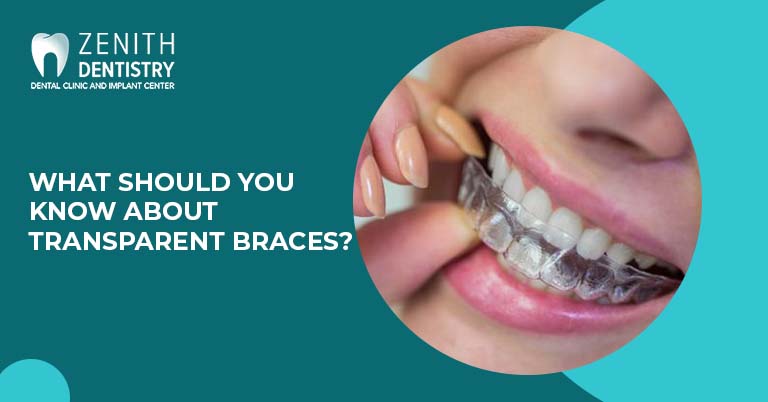
What should you know about transparent braces?
Ceramic braces, also known as clear braces, are an orthodontic appliance that is used to straighten teeth and cure other dental alignment disorders.
Clear braces are like regular metal braces. They work by applying light pressure to the teeth over time to gently shift them into their intended positions. The main distinction is that transparent braces use tooth-colored or translucent ceramic brackets and wires, which are less visible than traditional braces’ obvious metal brackets.
Here’s how transparent braces operate in general
- Brackets – Clear braces use brackets that are either totally or partially constructed of ceramic material. These brackets, like metal brackets in traditional braces, are glued to the front surface of the teeth.
- Archwires – Clear braces, like metal braces, employ archwires to link the brackets and guide tooth movement. The orthodontist adjusts the archwire on a regular basis to manage the direction and degree of tooth movement.
Elastics or rubber bands may be used with transparent braces to correct bite abnormalities such as overbites or underbites, depending on your unique orthodontic needs. To preserve a modest appearance, these elastics can also be tooth-colored.
How clear braces better than orthodontic appliances?
The clear braces are intended to be less visible than traditional metal braces, which may appeal to many people, particularly adults and teenagers concerned about the aesthetics of their orthodontic treatment.
Likely, they are more advantageous than other teeth straightening appliances like traditional braces as follows:
- Effectiveness – Clear braces can be just as successful as metal braces in addressing a wide range of orthodontic disorders such as crowded teeth, gaps, overbites, underbites, and more complex instances. Clear braces, in addition to their efficiency, have the advantage of being less visible than standard metal braces. This is especially tempting to people who are worried about the aesthetics of orthodontic treatment.
- Durability – Clear braces are often more durable than metal braces, although the ceramic material is more prone to chipping or splitting. This is something to think about if you participate in contact sports or have behaviors that could harm your brackets. It’s worth noting, though, that advances in ceramic braces have made them tougher and more resistant to injury. Furthermore, your orthodontist can give you ideas and guidelines on how to protect your braces during physical activities or when engaging in risky practices.
- Comfort – When compared to traditional braces, clear braces have smoother and more comfortable brackets, which can lessen irritation and pain in the mouth. Clear braces, in addition to having smoother brackets, are constructed of a material that is less likely to produce friction between the gums and cheeks. This improves the overall comfort level of patients who wear it.
- Comfort – When compared to typical metal brackets, clear braces often have smoother and more rounded brackets that are more comfortable and cause less irritation to the cheeks and lips.
- Customization – Clear braces come in a variety of ceramic material shades to match the color of your teeth, which can improve their visual appeal.
What are the limitations of Ceramic Braces?
- Expensive – Because of the unique materials utilized, clear braces are frequently more expensive than standard metal braces.
- Discolored quickly – The ceramic material used in clear braces can be stained by certain foods and beverages, necessitating extra care with dental hygiene and dietary choices.
How should you maintain your clear braces?
Clear braces must be cleaned on a regular basis to avoid discoloration, as some foods and drinks can discolor the brackets. Traditional metal braces are less likely to discolor, but they also necessitate careful oral hygiene.
- Brushing your teeth after every meal is essential when wearing transparent braces to eliminate any food particles that may become lodged in the brackets.
- Using a mouthwash or rinse advised by your orthodontist can also help keep your transparent braces clean and stain-free.
Can people of all ages can use ceramic braces for teeth straightening?
Clear braces are popular among adults and teenagers who choose a more discrete choice. Metal braces, on the other hand, may be a more practical option for adolescents or teenagers who are less conscientious about cleaning and maintenance.
The optimal treatment choice for you will eventually be determined by your orthodontist’s advice. Before offering the best treatment option, they will assess your individual dental needs, the severity of your orthodontic concerns, and your preferences. Traditional braces, which are excellent for addressing a wide range of tooth disorders, may be recommended by your orthodontist.
They may also suggest clear aligners, such as Invisalign, for a more discrete and convenient treatment alternative. Finally, the selection will be based on a thorough evaluation of your specific case to guarantee the best possible outcome for your oral health.
It’s important to consult with an experienced orthodontist to discuss your options and determine which teeth-straightening appliance is best for your individual case. They can provide personalized recommendations based on your oral health, treatment goals, and lifestyle factors. An experienced orthodontist will also consider factors such as the severity of your misalignment, your age, and any previous dental work you may have had. They can help you understand the pros and cons of different appliances, such as braces or clear aligners, and guide you towards the most effective treatment plan for achieving a straighter smile.






